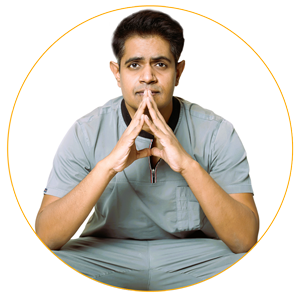Carpal Tunnel Syndrome Median Nerve Palsy
Compression of median nerve at the wrist is named as carpal tunnel syndrome (CTS).

Compression of median nerve at the wrist is named as carpal tunnel syndrome (CTS). CTS causes numbness, tingling and weakness in fingers of the hand. It happens when there is increased pressure within the wrist on a nerve called the median nerve. This nerve provides sensation to the thumb, index, and middle fingers, and to half of the ring finger. The small finger (the "pinky") is typically not affected.
Median nerve is one of the major nerves of forearm and hand. It originates from brachial plexus in the arm pit. Median nerve compression is a mononeuropathy that causes motor and sensory loss majorly in hand. Median nerve can also be compressed near the elbow or in the forearm apart from at the wrist.
The carpal tunnel is a narrow canal or tube in the wrist. Similarly, to a tunnel you could travel through by car, this tunnel allows the median nerve and tendons to connect the hand and forearm.
Who is at risk for carpal tunnel syndrome?
Carpal tunnel syndrome is also more common in women than in men in their middle age.
- People who do activities that involve repetitive finger or hand use. Motions that can place people at risk of developing carpal tunnel syndrome include hammering, extreme wrist motions and vibration.
- After or during Pregnancy.
- In dialysis patients
- Wrist factures and dislocation.
- Arthritic diseases such as rheumatoid arthritis and gout.
- Hypothyroidism
- Diabetes.
- Alcoholism
- A mass (tumor) in the carpal tunnel.
Symptoms in Carpal Tunnel Syndrome
Carpal tunnel syndrome is caused when the space (the carpal tunnel) in the wrist narrows. This presses down on the median nerve and tendons (located inside the carpal tunnel), which cuts off sensation in the fingers and hand.
Symptoms usually begin slowly and can occur at any time. Early symptoms include:
- Numbness at night.
- Tingling and/or pain in the fingers (especially the thumb, index and middle fingers).
In fact, because some people sleep with their wrists curled, night time symptoms are common and can wake people from sleep. Shaking the hands helps relieve symptoms in the early stage of the condition.
Common daytime symptoms can include:
- Tingling in the fingers.
- Decreased feeling in the fingertips.
- Difficulty using the hand for small tasks, like:
- Handling small objects/ utensils.
- Writing.
As carpal tunnel syndrome worsens, symptoms become more constant. These symptoms of progression include:
- Weakness in the hand.
- Inability to perform tasks that require delicate motions (such as buttoning a shirt).
- Dropping objects.
In the most severe condition, the muscles at the base of the thumb visibly shrink in size (atrophy) or the patient develops tiny ulcers due to burns on the finger tips
Diagnosis of Carpal Tunnel Syndrome
Diagnosis of carpal tunnel syndrome is mostly clinical where a proper history, clinical examination and detail of pre-existing diseases help in arriving at proper diagnosis. Two clinical tests commonly done are-
- Phalen's test - Individuals with carpal tunnel syndrome will experience numbness and tingling in the fingers within 60 seconds in reverse namaste position. The more quickly symptoms appear, the more severe the carpal tunnel syndrome.
- Tinel's sign – Tapping on the wrist in the region of median nerve where elicit tingling and pain sensation in the thumb, index finger and middle finger
Few investigations are done to confirm the diagnosis-
- Nerve Conduction Velocities (NCV) and Electro-Myographic Studies (EMG) of the affected hand is quite diagnostic for carpal tunnel syndrome
- MRI of the wrist is done in few cases
- HR Ultrasonography of the wrist can also be done to see for the thickness of the nerve before it enters the canal
Treatment of Carpal Tunnel Syndrome
Carpal tunnel syndrome can be treated non-surgically or with surgery. Non-surgical treatments are used for less severe cases and allow you to continue with daily activities without interruption. Surgical treatments can help in more severe cases and have very positive outcomes.
Non-surgical treatments
Non-surgical treatments are usually tried first. Treatment begins by:
- Wearing a wrist splint at night.
- Taking nonsteroidal anti-inflammatory drugs, such as ibuprofen.
- Steroid injections.
Other treatments focus on ways to change your lifestyle to decrease symptoms. This is often seen in the workplace, where you can make modifications to help with carpal tunnel. These changes might include:
- Raising or lowering your chair.
- Moving your computer keyboard.
- Changing your hand/wrist position while doing activities.
- Using recommended splints, exercises and heat treatments from a hand therapist.
Surgical treatments
Surgery is recommended when carpal tunnel syndrome does not respond to non-surgical treatments or has already become severe. The goal of surgery is to increase the size of the tunnel in order to decrease the pressure on the nerves and tendons that pass through the space. This is done by cutting (releasing) the ligament that covers the carpal tunnel at the base of the palm. This ligament is called the transverse carpal ligament.
- After all the pre-operative investigations and management of diabetes and hypothyroidism, surgery is planned
- Surgery is done usually in brachial plexus block or General Anesthesia.
- A small incision is given about the wrist and carpal tunnel is released
- Finger movements are started once the effect of brachial plexus block is gone or when the patient is out from in anaesthesia.
- You might be in brief discomfort for about 24 to 72 hours after surgery.
- People usually experience complete night-time symptom relief quickly—even the night after surgery
- Wrist immobilization is done till sutures are removed.
- Sutures are removed after a period of 10-12 days.
- Physiotherapy post operative is most important for hand, wrist and fingers
- Prognosis is good if muscle atrophy has not started.
- You might be unable to do heavier activities with the affected hand for about four to six weeks.
Points to remember in Carpal Tunnel Syndrome
Recovery times can vary depending on your age, general health, severity of carpal tunnel syndrome and how long you had symptoms. You will continue to gain strength and sensation in the following year after surgery.
- Surgery for carpal tunnel syndrome has a very high success rate of over 95%. Many symptoms are relieved quickly after treatment, including tingling sensation in the hands and waking up at night. Numbness may take longer to be relieved, even up to three months. Surgery won't help if carpal tunnel syndrome is the wrong diagnosis.
- When the carpal tunnel syndrome has become severe, relief may not be complete.
- There may be some pain in the palm around the incisions that can last up to a few months.
- Other after-surgery pain may not be related to carpal tunnel syndrome.
- Only a small percentage of patients do not gain substantial relief from symptoms. These are the patients who either had severe carpal tunnel syndrome, had a nerve that was not completely released during surgery, or did not really have carpal tunnel syndrome.
Management of Median Nerve Palsy/ Late cases of the carpal tunnel syndrome
If the patient has presented very late and muscles of hand (base of thumb) have atrophied, then he or she would not be able to bring out thumb in perpendicular direction to the palm when hand is placed flat on the table. There would be loss of coarse movements of the hand with complete loss of sensation over the thumb, index, middle and half of ring finger.
Such condition is usually seen in long standing compression of the median nerve or injuries of the median nerve or in patients with leprosy.
- If the median nerve is damaged, then surgical excision of the damaged part and nerve repair/grafting should be done within 1 year of the injury
- If the patient has presented with sudden onset of paralysis of median nerve, then other neurological causes or leprosy should be investigated for. In many of such cases, release of carpal tunnel nerve is done and a nerve and muscle biopsy is taken to confirm the diagnosis of neurological disease or leprosy.
- If the patient has presented late beyond the timing suitable for nerve repair (after 1 year of the accident), then tendon transfers should be done to strengthen the weak portions of the hand along with the nerve repair and grafting. A strong tendon of the hand is re-routed to substitute a weaker or lost movement of the hand.
- If the median nerve is damaged, then surgical excision of the damaged part and nerve repair/grafting should be done within 1 year of the injury
- If the patient has presented with sudden onset of paralysis of median nerve, then other neurological causes or leprosy should be investigated for. In many of such cases, release of carpal tunnel nerve is done and a nerve and muscle biopsy is taken to confirm the diagnosis of neurological disease or leprosy
- 6. If the patient has presented late beyond the timing suitable for nerve repair (after 1 year of the accident), then tendon transfers should be done to strengthen the weak portions of the hand along with the nerve repair and grafting. A strong tendon of the hand is re-routed to substitute a weaker or lost movement of the hand.
During tendon transfers for median nerve palsy, one tendon from the front of the hand is taken, re-routed and sutured to the tendon of the outer aspect of the thumb so that the patient can abduct (bring out thumb) and also make a meaningful pinch with the other fingers so as to hold objects with the thumb and fingers (OPPONENSPLASTY)
The surgery is usually done under brachial block or general anaesthesia and a splint or slab is given for immobilization in the post operative period. The patient is usually discharged second day after the surgery. Sutures are removed 14 days after surgery.
Splint is removed 3 to 4 weeks after the surgery and gradual training of the transferred tendon is started so that it may regain its newly assigned function.
If the patient has presented very late and muscles of hand (base of thumb) have atrophied, then he or she would not be able to bring out thumb in perpendicular direction to the palm when hand is placed flat on the table. There would be loss of coarse movements of the hand with complete loss of sensation over the thumb, index, middle and half of ring finger.
Such condition is usually seen in long standing compression of the median nerve or injuries of the median nerve or in patients with leprosy.
During tendon transfers for median nerve palsy, one tendon from the front of the hand is taken, re-routed and sutured to the tendon of the outer aspect of the thumb so that the patient can abduct (bring out thumb) and also make a meaningful pinch with the other fingers so as to hold objects with the thumb and fingers (OPPONENSPLASTY)
The surgery is usually done under brachial block or general anaesthesia and a splint or slab is given for immobilization in the post operative period. The patient is usually discharged second day after the surgery. Sutures are removed 14 days after surgery.
Splint is removed 3 to 4 weeks after the surgery and gradual training of the transferred tendon is started so that it may regain its newly assigned function.
Cubital Tunnel Syndrome Median Nerve Palsy Images
Indivisual results may vary from person to person.
These pictures are shown for the purpose of education only.


Know your surgeon better

Best plastic surgeon, Dr. Amit Agarwal is an American Board Certified, extensively trained, and best Plastic & Aesthetic surgeon in Lucknow. He is the Chief Plastic Surgeon heading the Department of Plastic, Microvascular, and Craniofacial surgery at Vivekananda Polyclinic and Institute of Medical Sciences, Lucknow, U.P, India. He maintains a busy practice at Avadh and Nishat Hospital and his own center - Kayakriti Plastic Surgery & Dental Center. He was formerly a Consultant in the Department of Plastic Surgery and Burns at the prestigious SGPGI, Lucknow.
MS, DNB (General Surgery) MCh, DNB (Plastic Surgery),
MNAMS, FACS, FICS, FRCS (Edinburgh, UK)
His Credentials
Three pillars of kayakriti
Privacy
We believe your experience with us should be comfortable and hassle-free to make it one of your best lifetime experiences for yours. We, here at the clinic, take full precautions to maintain your privacy in any manner. We also provide a staff who will receive you from the gate and take you to the chamber directly if you demand.
Trust
Our Surgeon is highly qualified and internationally certified with a team of skilled staff to perform any surgical or non-surgical treatment on your body.
Safety
When you plan to undergo any surgery you should always keep in mind that it's your body and it's a surgery. We, here always keep your safety a priority and will never recommend you to undergo any such procedure which is not safe for you. We also provide you with a detailed description of the complications which may occur after the surgery during the consultation as it's a surgical procedure so there may be some complications depending on the way your body reacts.
Kayakriti in news



Frequently Asked Questions
If you have flat or small breast and you want to improve your breast and hip contour ratio then you are a good candidate for it. The answer will be best provided after the first consultation with Dr Amit Agarwal.
Acute pain will be there for almost a week which gradually reduces and there will be soreness and swelling which may take up to 3 weeks to subside.
You can join your work and daily routines after a week of the procedure and can start exercising after 3 weeks of it.
Yes, you have to wear it round the clock unless we suggest you to remove it.
This surgery does not affect the ducts or the areas of the breast involved in milk production. Thus, it does not affect the breast feeding.
This surgery does not affect the ducts or the areas of the breast involved in milk production. Thus, it does not affect the breast feeding.












Kayakriti Plastic Surgery & Dental Center
D-43, Near Punjab National Bank, Rajajipuram, Lucknow, Uttar Pradesh - 226017, India
Phone No. +919695940009, +919695940006
Map Location





























Social Media Presence